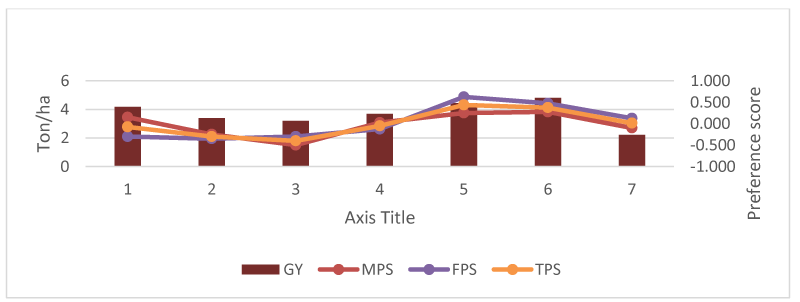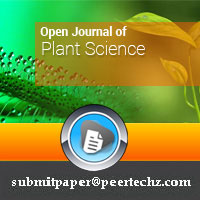Open Journal of Plant Science
Varietal Evaluation and Preference Analysis of Promising Spring Rice Genotypes in Dhamilikuwa, Lamjung, Nepal
S Subedi*, S Sharma, A Poudel, S Adhikari and VKC
Cite this as
Subedi S, Sharma S, Poudel A, Adhikari S, VKC (2018) Varietal Evaluation and Preference Analysis of Promising Spring Rice Genotypes in Dhamilikuwa, Lamjung, Nepal. Open J Plant Sci 3(1): 015-017. DOI: 10.17352/ojps.000009A participatory varietal selection trial on Spring Rice (Oryza sativa L.) was conducted at Farmer’s field of Dhamilikuwa, Lamjung, Nepal with objective to identify high yielding promising spring rice genotypes suitable for marginal soils and farmer’s interests during spring season 2017. Seven spring rice genotypes including local check variety (Dhamilikuwa local) were laid out in randomized complete block design (RCBD) with three replications. Results revealed that yield and yield attributes were statically different among genotypes except spikelet fertility. Maximum grain yield was found in Hardinath-1 (4.81 ton/ha) which was statically similar with genotypes OM2574, PK 19333-9-9-1-1-5-5-4-1 and superior than local check variety (Dhamilikuwa local), IR 09N-503, IR 09N-538 NR 2168-65-1-1-1-1-1. On participatory varietal selection, the farmer preference score was found maximum in genotype PK 19333-9-9-1-1-5-5-4-1 which signifies this genotype may have certain traits of farmer preference.
Introduction
Rice (Oryza sativa L.) is one of the pivotal staple cereal crops feeding more than 3.5 billion people worldwide (IRRI, 2017). Oryza sativa L. belonging to Family Poaceae, Sub-family Oryzoideae, tribe Oryzae with chromosome number 24 i.e. 2n = 24 [1]. Rice ranks third most staple crop after Maize & Wheat in world in terms of production [2]. Its annual production in world was 741.4 million ton with yield of 4.55 t/ha [3]. Rice ranks first important staple crop of Nepal followed by Maize, Wheat, Millet and Barley. It accounts for one-fifth of total agricultural GDP of the country. Nepal is rich in rice genetic resources with 1,700 rice landraces growing from 60 to 3,050 m altitude [4]. Rice production, production area and productivity in Nepal during fiscal year 2015/2016 was 42, 99, 079 ton, 13, 62, 908 ha & 3.15 ton/ha. Likewise, in Western Development Region its production and production area were 11, 08, 932 ton & 3, 08, 090 ha respectively. Similarly, in Western hills, its production and area of production were 4, 05, 912 ton & 1, 23, 850 ha respectively [5]. Similarly, in Lamjung district rice production area, production & productivity of rice during 2015/16 fiscal year were recorded to be 14, 059 ha, 37, 772 ton & 2.687 ton/ha respectively [6].
Food insecurity has grown as a major problem to focus in recent scenario of Nepal. In addition, rapid population growth has increased daily food demand [7]. Furthermore, in recent decade’s climate change and natural calamities like drought, flood, pest infestation and fluctuation in rainfall pattern are extra risk factors to have food secured condition (Bhandari, 2015). Use of adaptable and high yielding variety is one of key factor in achieving rice sufficiency (Christian, 2015). Spring rice is a short durational, resistant to many diseases and pests, photoperiod insensitive rice with high yield potential. Being as spring season rice, commonly grown in those place having abundant irrigation facility helps to minimize the weed infestation. Higher intensity of light during spring resulting the higher yield. Spring rice also can grow in those area prone to flood and landslide during rainy season. Besides the drought problem in Asia, problem of weeds, and flooding is prevalent in rice production system so adaptation of improved spring rice varieties has been popular (IRRI, 2017). Plant breeders develop varieties isolated from active farmers and release varieties that are most productive under ideal conditions, often they are not suitable for marginal farm conditions, like sodic lands [8]. Therefore, PVS facilitates development of varieties suitable for marginal soils and farmers’ interests. Farmers became a part of the variety/genotype selection and testing process in order to incorporate their preferences, which were crucial for the large-scale adoption of the selected variety/genotype.
Inappropriate genotypic/varietal evaluation and selection on our country had led to the less development of variety with high yield potential. Improvement and participatory selection of promising spring rice genotypes by study the genetic variability, character association between yield traits and farmer preference analysis helps in rice breeding for development of best spring rice varieties in western hill of Nepal.
Materials and Methods
The experiment was carried out at farmer’s field of Dhamilikuwa, Lamjung, Nepal situated at 28.09°N latitude, 84.47°E longitude and altitude of 607 m above mean sea level. The experiment was laid out in a Randomized Complete Block Design (RCBD) with three replications. The experimental material was planted in three blocks. Each block consisted of eight genotypes randomized and replicated within each block. Twenty seven days old seedlings were transplanted 20cm apart between rows and 20cm within the row. All necessary precautions were taken to maintain uniform plant population in each treatment per replication. All the recommended package of practices was followed along with necessary prophylactic plant protection measures to raise a good crop. Observations were recorded and the data was subjected to statistical analysis. Preference analysis through casting votes was conducted when most variety reached around 80% maturity [9]. Preference score was determined by CGIAR model using positive votes, negative votes and total votes casted (CIAT, 2013). At first, we collected the farmer basic information and explained the protocol and introduced them with layout. Each plot was provided with bag for collecting ballots. Farmers were provided with four ballots to vote for two best and two worst lines. Farmers explained their choices and voted accordingly. Then preference score for men and women was computed independently from counted positive and negative ballots collected in each ballot box. Independent count was because of men and women may have common and different varietal preference and needs based on gender roles and socio-economic status. Therefore their opinions should be considered in varietal improvement. Preference score was calculated by,
Statistical analyses for the yield and yield attributes were done through F-test in R-stat and preference analysis was done on CGIAR model [10].
Results and Discussion
Yield and yield attributing characters
The yield and yield components performance of different genotypes are presented in table 1. The result showed grain yield of Hardinath-1 is significantly superior than Dhamilikuwa local, IR 09N-503, IR 09N-538 NR 2168-65-1-1-1-1-1 and statistically at par with OM2574, PK 19333-9-9-1-1-5-5-4-1. Likewise Hardinath-1 showed maximum yield and also recommended by Agronomy society of Nepal (ASoN) [11]. Similarly, maximum effective tillers was found in Hardinath-1 which is statically similar to IR 09N-503, IR 09N-538, OM2574 and superior than NR 2168-65-1-1-1-1-1, PK 19333-9-9-1-1-5-5-4-1, Dhamilikuwa local. Chlorophyll content at 60 days after transplanting is statistically superior in Hardinath-1 than rest all. Days to heading and maturity are seen shorter in Dhamilikuwa local, followed by hardinath-1 and PK 19333-9-9-1-1-5-5-4-1. Panicle length is longer in hardinath-1 and followed by IR 09N-538 while other being statically inferior. Likewise harvest index and test weight is significantly superior in hardinath-1 and followed by NR 2168-65-1-1-1-1-1, PK 19333-9-9-1-1-5-5-4-1, OM2574, IR 09N-538, Dhamilikuwa local. Plant height was found statically shorter in hardinath-1, IR 09N-503, NR 2168-65-1-1-1-1-1and PK 19333-9-9-1-1-5-5-4-1 than OM2574 and Dhamilikuwa local.
Preference analysis
The preference score of different spring rice genotypes on participatory varietal selection were presented in table 2. The total preference score was found highest in PK 19333-9-9-1-1-5-5-4-1 followed by hardinath-1. Male prefer hardinath-1 and then PK 19333-9-9-1-1-5-4-1. Female preference score is highest on PK 19333-9-9-1-1-5-5-4-1 followed by hardinath-1. Higher preference of PK 19333-9-9-1-1-5-5-4-1 is due to early maturity, robust grain, larger flag leaf area and shorter the plant height. Also, hardinath-1 has also higher number of tillers, larger panicle and robust grain. The preference score is minimum in IR 09N-538 followed by IR 09N-503.Male preference score is minimum in IR 09N-538 and female preference score is minimum in IR 09N-503 is due to delay maturity, less number of tillers and shorter panicle.
However grain yield was maximum in Hardinath-1, the preference score was maximum in PK 19333-9-9-1-1-5-5-4-1 on participatory varietal selection. This indicates PK 19333-9-9-1-1-5-5-4-1 have some gene of farmer interest. The preference score of genotypes IR 09N-503, IR 09N-538 was minimum, however yield was minimum in than Dhamilikuwa local. This was due to longer growth period of genotypes IR 09N-503 and IR 09N-538 (Figure 1).
Conclusion
From this research, it has been concluded that proper varietal evaluation and participatory varietal selection is key to strength food security and mitigate undernourished/malnourished condition of Nepal. Hardinath-1 is high yielding spring rice variety and PK 19333-9-9-1-1-5-5-4-1 is most preferred genotypes by farmer on participatory varietal selection. In this way we can conclude, Farmer not only focus on grain yield but also on maturity days, plant performance and other yield components. As a researcher, I found, genotypes PK 19333-9-9-1-1-5-5-4-1 may have certain traits of farmer interest.
- Grist DH (1986) Rice. The origin & history of rice, 6th ed. Longman Inc. New York, USA 3-6. Link: https://goo.gl/sj78Z1
- National Geographic Society (2017) Staple food crops of the world. Link: https://goo.gl/GPktNM
- Food and Agriculture Organization of the United Nations (2017) Food and Agriculture, Organization Statistical Databases. Link: https://goo.gl/TQaUpq
- Mallick RN (1981/82) Rice in Nepal, Kalaprakanshan, Kathmandu, Nepal. Link: https://bit.ly/2IjZrPK
- CBS (2015) Nepal in Figure 2015, Central Bureau of Statistics. Nepal Planning Commission. Link: https://goo.gl/KHrG4b
- MoAD (2015) Statistical Information on Nepalese Agriculture. Ministry of Agricultural Development, Singh Durbar, Kathmandu, Nepal 207. Link: https://goo.gl/Eg81k6
- Basnet BMS (2008) Environment friendly technologies for increasing rice productivity. The Journal of Agriculture and Environment 9: 34-40. Link: https://goo.gl/1ivVKE
- Singh YP, Nayak AK, Sharma DK, Gautam RK, Singh RK, et al. (2013) Farmers’ Participatory Varietal Selection: A Sustainable Crop Improvement Approach for the 21st Century. Agroecology and Sustainable Food Systems. Link: https://goo.gl/R4S5V3
- Paris T, Manzanilla D, Tatlonghari G, Labios R, Cueno A, et al. (2011) Guide to Participatory Varietal Selection for Submergence-tolerant Rice. International Rice Research Institute, Los Baños, Philippines. Link: https://goo.gl/X2MyVJ
- Guerrero MDP, Ashby JA, Gracia T (1993) IPRA project and CIAT (international center for tropical agriculture). Farmer evaluation of technology. Preference ranking. Instructional unit No 2. Colombia 129. Link: https://goo.gl/P4s24M
- CDD (2017) Rice science and technology in Nepal. Crop development directorate. Department of agriculture, hariharbhawan. Link: https://goo.gl/FFrxQJ
- Palanog AD, Tayson C, Ciocon IMG, Ines LTS, Bibar JEA, et al. (2015) Grain yield performance and stability analysis of rice varieties under rain-fed lowland conditions of Western Visayas, Philippines. Asia life sciences 24: 399-408. Link: https://goo.gl/sBFdtJ
- CDD (2015) Rice varietal mapping in Nepal. Plant Protection Directorate, Department of agriculture, Hariharbhawan. Link: https://goo.gl/YevfZ1
Article Alerts
Subscribe to our articles alerts and stay tuned.
 This work is licensed under a Creative Commons Attribution 4.0 International License.
This work is licensed under a Creative Commons Attribution 4.0 International License.


 Save to Mendeley
Save to Mendeley
